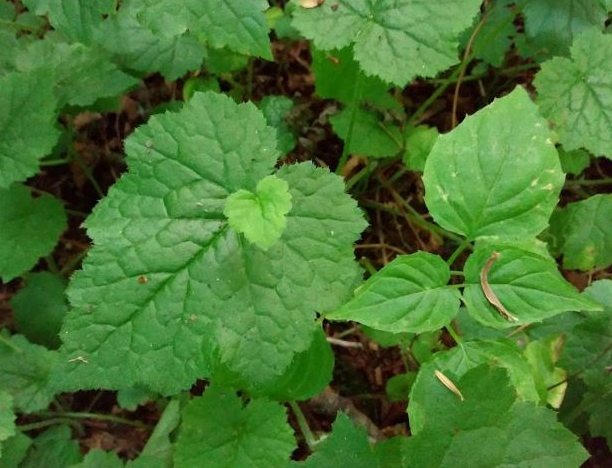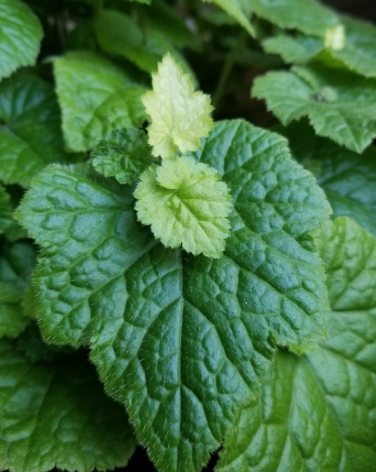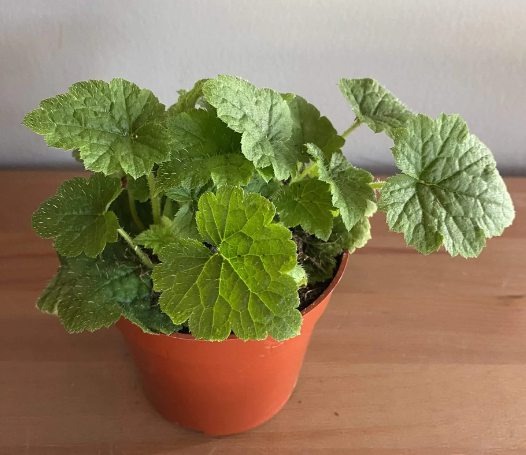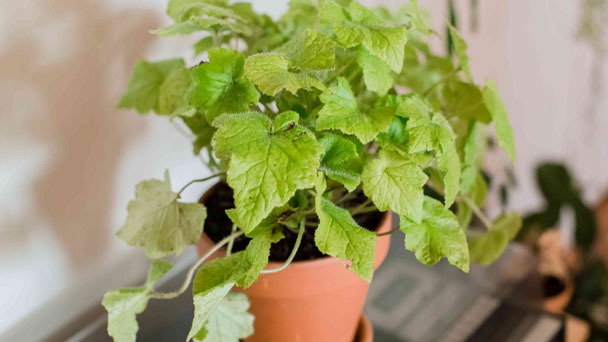The piggyback plant is well known for being a low-maintenance houseplant. The piggyback plant, which is indigenous to western North America, can be found all the way up into Alaska from northern California. Whether grown inside or outside, piggyback plants require little maintenance.
This evergreen has maple-shaped, hairy leaves with scalloped edges that are lush, green, and hairy. Forming a striking mound of foliage are ornamental leaf patterns. But how it creates new plants is the feature that captures attention. Mature leaves produce new plantlets at the top of their petioles, which are the attachment points for the leaves to the stem. The common names "piggyback plant," "youth-on-age," and "thousand mothers" come from this peculiar growth pattern.

Piggyback Plant Description
When you see the vivid new plantlet sprouting from the base of the old leaf, it doesn't take much imagination to understand why it is called a piggyback plant. It rides piggyback to a new life in addition to piggybacking on the old growth. The old leaf sags and touches the ground as the little one gets bigger. At the point of contact, roots develop. Over time, the old leaf decays into the soil, making way for a brand-new, independent plant.
Other names for this plant, according to Washington State University, include Thousand Mothers and Youth on Age. These names do a great job of describing these plants.
Piggyback Plant Care
Location & Light
The best places to keep piggyback plants are in indirect light that is not directly overhead or in complete darkness. If reading a newspaper with your back to the window is possible, those who are concerned that the room will be too dark can relax. We advise placing a Piggyback Plant under a grow light, two meters from any other window, or a north-facing window.
Temperature
Piggyback Plant prefers cool to average warmth with a minimum temperature of 100C. Cold drafts should be avoided because they can make your Piggyback Plant lose leaves.
Soil
The ideal soil for Piggyback Plant should be nutrient-rich, organically rich, and free-draining to keep it from becoming soggy.
Water
It is best to keep Piggyback Plants in consistently moist soil because inconsistent moisture levels can lead to crisped growth and an unhappy plant. Between waterings during the growing season, let the top third of the compost dry out. In the fall and winter, reduce this even more. Under-watering symptoms include dehydrated foliage, leaf-plantlet death & browned areas forming on the leaf edges. Remember that the brighter the area, the more watering you'll need to do. These problems are typically brought on by excessive light/heat or simple forgetfulness. Over-watering symptoms include the central foliage beginning to yellow rot, little to no new growth, yellowing lower leaves and eventual plant death. To learn more about root rot and how to treat it, click here, especially if you believe that over-watering caused your plant's demise.
Humidity
Although Piggyback Plants can survive in homes with average room humidity, making a humidity tray will not only give your plant a moist and stable environment, but it will also reduce the likelihood of dehydration. When used in close proximity to an active heater, this technique is especially beneficial for those who regularly dehydrate their specimens.
Fertilisation
When the plant is growing, fertilize every four days. In the fall and winter, reduce fertilization to every six days. Although an "All-Purpose" fertilizer will still work, we advise using a fertilizer specifically designated for "Houseplants" because it will provide the essential thirteen nutrients that this species needs to grow.
The piggyback plant is a low-maintenance houseplant that offers high rewards. It's also one indoor plant you can grow without being accused of favoring non-native plants.
Species Location
This native species of the Pacific Northwest woodlands is this emerald-green gem. It grows wild in cool, moist, and shady forest floors and is known as Tolmiea menziesii, after William Fraser Tolmie. Its common name is the piggyback plant. In USDA Zones 6 through 9, you can grow it in the garden in a shaded spot or keep it as a lovely houseplant.
How to Repot Piggyback Plant
Only when the plant has become pot-bound should Piggyback Plant be repotted during the growing season. Use a larger pot and rich, well-draining soil.
To avoid the soil becoming soggy, which can cause root-rot disease and ultimately cause your plant to die, make sure the pot has a drainage hole.
How to Prune Piggyback Plant
To keep your Piggyback Plant tidy, regular removal of dead foliage is required. Pinch off the growing tips on a regular basis to promote a bushy, compact growth in your Piggyback Plant.
Pests and Diseases
Your prickly plants may become a meal for mealybugs. When you water the plant, look for infestation on the tender stems and underneath the leaves. Take the plant outside and give it a thorough spraying if you notice any white powdery substance or the soft-bodied mealybugs. Apply neem oil spray or a systemic insecticide like imidacloprid to the soil as a follow-up organic insect repellent.
In particular with plants kept in warm, dry environments, spider mites can be a problem. Use a systemic insecticide if you notice fine webbing on the undersides of the leaves or in between them, and then mist the plant frequently or keep water in a pan with pebbles close to the plant to maintain moisture in the air.
Indoor Piggyback Plant Care
Because of its lovely evergreen foliage, which is slightly lobed like ivy, this interesting plant is grown indoors. The leaves' margins have serrated edges and are hairy. Viewed in contrast to the mature leaves' darker hues, the light green plantlets provide a faint pop of contrast. There's a variegated type named Tolmiea menziesii "Taff's Gold," which is a bit brighter with its green and creamy yellow, mottled leaves.
- Container - Although they can be grown in pots, hanging baskets are where piggyback plants are most frequently grown. Containers that are wider than they are deep are best because the roots of these plants run along the soil's surface. To avoid water logging, proper drainage is necessary.
- Soil - Like a woodland plant should, the piggyback plant prefers humus-rich, draining soil.
- Light - Despite the fact that they can also survive in low light, these plants do best in moderate lighting. A west or east exposure or strong indirect light will do.
- Water - Prior to watering, it is best to inspect the soil surface. Only if the soil is particularly dry should you add more water. Although it thrives in moist soil, this plant doesn't like to sit in water.
- Fertilizing - During their active growing season, which lasts from May to September, piggyback plants benefit from some top feeding. An all-purpose liquid fertilizer can be applied once a month and will do the trick. After this time, the growth slows, so until the following growing season, feed it only once every two months.
- Pruning - Your hanging plants will grow unevenly and in a scraggly manner after the initial bushy growth. This is due to the fact that, unlike in a garden, the new plantlets cannot take root and cover the existing foliage with fresh foliage. Simply cut the lanky stems off.
- Repotting - The growth suffers and the plant will appear weak if it has become root-bound. Another sign that a plant is root-bound and requires repotting is when all the water seems to simply run out of the drainage holes as soon as you water it. The best time to repot a plant is in the spring, when the plant will recover more quickly due to its active growth. Excess roots and branches should be cut off after you remove the plant from the pot. Plant it in the center of a larger pot filled with rich, well-draining soil. Keep it well-watered and in full sunlight.

Caring for Outdoor Piggyback Plants
In moist, shady areas of the garden, piggyback plants will create a carpet of greenery. They can be used as groundcover beneath trees, where the dappled light and added humidity will promote their lush growth. In areas with some or all shade, they work well as borders and bedding plants.
A low maintenance groundcover is effectively provided for the area by this plant, which grows to a height of 1 to 1 ½ feet and spreads to a radius of 3 to 6 feet.
- Light - The piggyback needs either complete or partial shade. If you keep the area moist, a little morning light is acceptable.
- Water - Depending on how quickly the soil dries up, provide water frequently. This plant prefers moist soil and struggles in dry environments.
- Fertilizer - In the spring and summer, fertilize with a foliar spray once per month; otherwise, less frequently.
- Flowering - Short flower spikes may be visible among the mass of green in the late spring to early summer. Small, brownish purple, and not especially eye-catching, each flower is only a single flower.
- Pruning - This plant has a naturally low growth rate, and its propensity for covering up older growth with new growth can be thought of as a form of self-pruning. However, by trimming the edges, you can prevent it from spreading past the defined area. A thick layer of bark or pebble mulch around the bed will keep the plant naturally contained because it will stop new growth from taking root in undesirable places.
Piggyback Plants Propagation
Tolmieas are perennial plants that can withstand cold temperatures up to USDA Zone 6, but they do not have a long lifespan. In about two years, they regenerate dead. Because of this, it's crucial to propagate frequently, ideally once a year, to maintain the stability of your collection.
Leaf Cuttings
A very affordable way to expand your collection is through cuttings.
- Put some moist potting soil in a tray.
- Pick healthy plantlets and mature leaves.
- Lift each leaf, leaving a ½ inch stalk attached, and cut it off.
- Poke holes in the soil with a tooth pick
- Each stalk should be inserted into a hole, and the leaf should be gently pressed down so that the point where the stalk joins the leaf blade hugs the soil.
- Keep the soil moist and put the tray somewhere bright.
In one to two weeks, roots will form, and the old leaves will begin to wither. You can move the plantlets into prepared pots once they have a solid foundation.
Divisions
Remove a crowded plant from its pot, and cut the root ball into a number of sections, each with a stem or two attached. Put them in a pot and water them often.
Seeds
Put the seeds in seed starting trays and keep them covered with a sheet of glass or plastic. You'll have sprouting tiny plants everywhere if you keep the soil moist. When they have four or five leaves, pot them individually.
Common Issues With Piggyback Plants
Yellowing Lower Leaves
Lower leaves that are yellowing may be a result of improper irrigation, but they can also be a sign of maturity. Both under- and over-watering may be to blame if older leaves turn yellow in quick succession. People are unaware that a plant's root system also needs access to oxygen; when soil is watered, air will rise up and escape from the potting soil. The roots will deteriorate over the next few days as a result of a lack of readily available oxygen. Make a watering schedule if yours has been neglected in the past to prevent forgetfulness in the future.
Crisped Foliage With Brown Leaf-edges
Lack of water and potential overexposure to the sun cause crisped foliage with brown leaf edges. Piggyback Plants thrive in bright environments, and those that haven't acclimated to the glaring rays may exhibit signs of sunburn and shock to their surroundings. Once the introductory period has passed, a brief morning sun is acceptable as long as the soil moisture is regularly monitored.
Root Rot
If your specimen is located in a dark environment with mould developing on the compost's top layer, use a chopstick to gently stab the soil in various areas. To avoid damaging the plant's lower portion, try to enter the compost between the plant's base and the pot's edge. In order to prevent the soil from becoming overly dry, leave the holes open for a few days before resurfacing it. Small invertebrates that live in the wild, such as worms, will be able to replicate the gentle change in the soil's structure.), but it'll also add oxygen back into the soil, thus reducing the risk of root rot. Repeat this every month or whenever you feel the potting mix isn't drying out quickly enough.
Mealybugs
Mealybugs are tiny, white creatures that resemble shells and slowly drain the sap from a plant's leaves. Check underneath the foliage, especially along the midrib, for cottony webs and vermin. Click here to read our article on getting rid of Mealybugs, which includes some additional advice you might not find elsewhere.
Failed Leaf-cuttings
There could be a number of causes for unsuccessful leaf-cuttings. Piggyback Plants should be propagated in the spring because they root more slowly and may even die if they are taken in the dormant months. Check the surrounding area to see if there is enough light to read a newspaper. If not, increase the amount of indirect sunlight it receives to enhance the growing environment. Additionally, you should never place it in direct sunlight as this will cause severe dehydration and, most likely, death. The success of the cutting will be greatly influenced by its overall size; cuttings that are 5 cm tall and have several leaves are most likely to root. Because the amount of stored energy in the leaves is less in smaller specimens, they won't root properly. To hasten the process of rooting, you can either remove the mother leaf—which will house the cutting—or leave it alone. To reduce the risk of bacteria growing in the container while the leaves are being propagated hydroponically, change the water every week. Maintain the foliage mostly above the waterline to avoid suffocation caused by yellow or browned areas that slowly rot away from poor sanitation or over-submersion. For more information on leaf-cuttings, scroll down to "Propagation"!

Piggyback Plant Origin
Native to the West Coast of America, piggyback plants can be found in southern Alaska, northern California, Oregon, Washington, and British Columbia.
Conclusion
The Piggyback Plant thrives in shade and grows from splayed underground stems. For the first two growing seasons, water your garden for the best results. Give Piggyback Plant regular waterings inside, and keep it out of direct sunlight. Plantlets, seeds, or fragments of the underground stem can all be used for year-round simple propagation.



